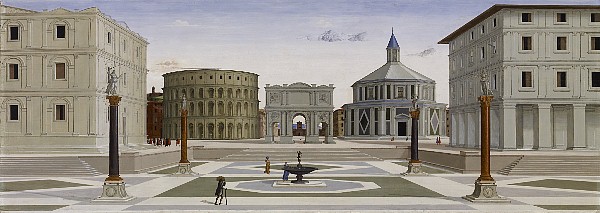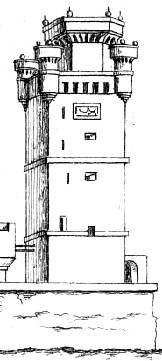Jacques Leroux
architect; d. 1510.
In 1480 Leroux replaced Ambroise Harel as supervising architect of the church of S. Maclou at Rouen, Seine-Inférieure, France, and November 18, 1494, he succeeded Guillaume Pontifs as architect of the cathedral of Rouen. In 1506 he completed the Tour de Beurre, at the cathedral, from his own designs.
Mathias von Böblingen
architect; d. 1505.
Mathias von Böblingen appears to have succeeded Moriz von Ensingen as architect of the cathedral of Ulm (Germany) about 1480. In 1492 the great tower at Ulm began to sink and part of the vaulting fell in. Probably on account of this accident Mathias retired to Ensingen in Switzerland.
Andrea Sansovino (Sansavino) (Andrea Contucci)
sculptor and architect; b. 1460; d. 1529.
According to Vasari, Andrea was the son of a labourer of Monte San Savino in Tuscany, and his first teacher was Antonio Pollajuolo. His earliest known work is a terra-cotta altar with figures of S. Lorenzo, S. Sebastiano, and S. Rocco, now in the monastery of S. Chiara at Monte San Savino, Italy. In 1480, on the recommendation of Lorenzo de' Medici (b. 1440; d. 1492), he was invited to Portugal by King John II. A bas-relief and a statue by him are still in the church of the monastery of S. Marco, near Coimbra (Portugal). In 1490 he returned to Florence, and was employed in the decoration of the church of S. Spirito. In 1500 Andrea was commissioned to execute the marble statues of Christ and S. John Baptist over the door of the Baptistery (Florence). The statues of the Madonna and S. John Baptist in the cathedral of Genoa were finished by him in 1503 (signed Sausovinus faciebat). His earliest work in Rome appears to be the monument of Pietro da Vicenza (dated 1564) in the church of Ara Coeli. His chief work, the monument of the Cardinal Ascanio Sforza, brother of Ludovico il Moro, Duke of Milan, at S. Maria del Popolo, was finished in 1506. The similar monument of the Bishop Hieronimus Bassus in the same church was begun in 1507. The monument of the Cardinal Johannes Michaelius and his secretary Antonio Orso in the church of S. Marcello (Rome) is by Andrea. Among his works in his native city (San Savino) is the cloister of S. Agostino, which is especially interesting on account of optical refinements introduced to correct the effect of its irregular plan. He built the great stairway between the cathedral and the bishop's palace at Arezzo.
Pietro Vanucci (Perugino)
painter; b. 1446; d. 1524.
For Sixtus IV (Pope 1471-1484) he painted a series of frescos in the Sistine Chapel, some of which were destroyed to make room for Michelangelo's Last Judgment. In 1499 and 1500 Perugino painted the decorations of the Sala del Cambio (Exchange) of Perugia, Italy, one of the most perfect examples of the decorative work of the fifteenth century.
Conrad Wogt
architect.
In 1480 he succeeded Jost Dotzinger as architect of the cathedral of Strasbourg (Elsass, Germany), and held that office until 1484.
| |

Fra Carnevale, Ideal City (c. 1480).
Fra Carnevale's painting of an ideal city, along with other paintings of a similar theme, make use of the new "science" of perspective to depict a virtual place, an imaginary environment composed of fanciful buildings and the open space the buildings create. The area presented, while ideal, is far from absurd; a contemporary Renaissance viewer of the painting, as well as a 20th century viewer, would feel secure and in familiar territory were they able to "walk into" the painting. That perspective, soon after its "discovery," had a momentous effect on theatrical scene design further reinforces the notion that perspectival views play a significant role in the creation of virtual space. In this light, the computer-aided "virtual realities" of the late 20th century are not totally new, but rather the continuation of a 500 year old "technology."
Regarding architecture, the numerous buildings displayed in each painting offer a unique and, at the time, unprecedented opportunity to comparatively view a vast variety of architectural styles, motifs, shapes, etc.--a virtual museum of architecture compactly reduced to a single glance.
| |

Tower, erected at Rhodes, by the Knights of St. John of Jerusalem, in the fifteenth century, and since restored by the Turks.
Seroux
|